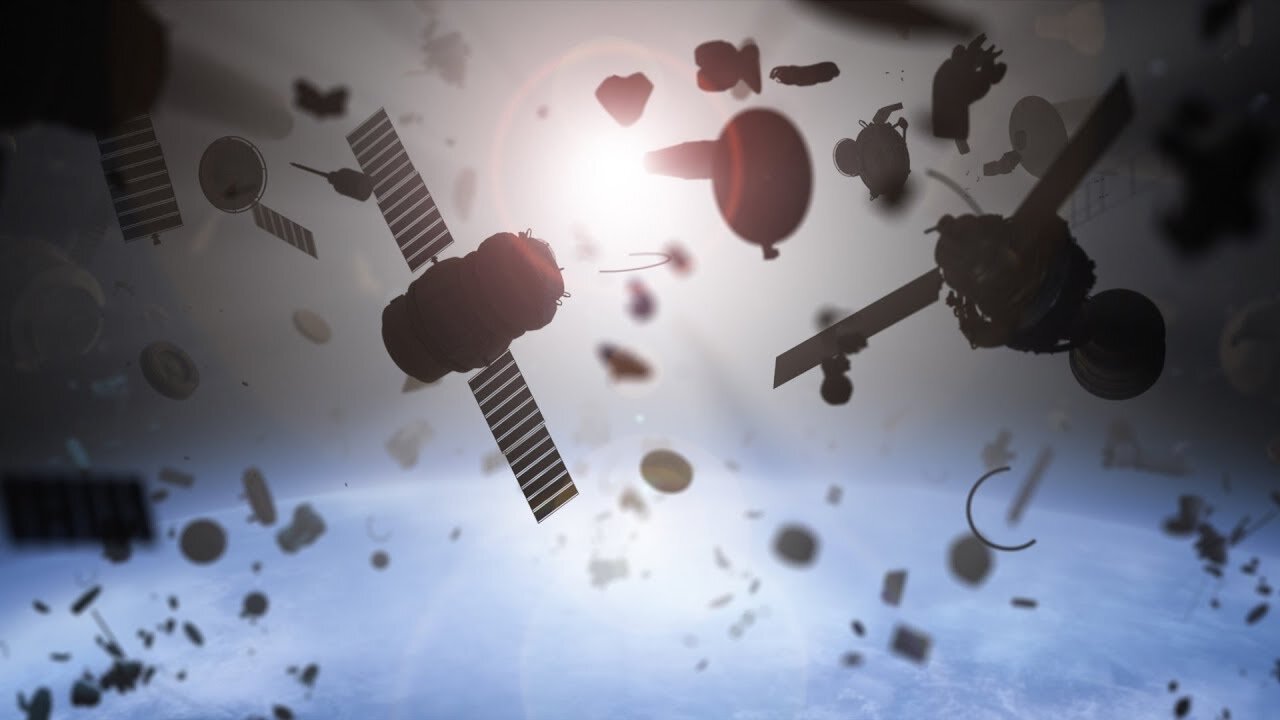Premium Only Content

Too Much Dangerous Space Junk Orbiting Earth Now At Critical Level
Music: Hello Moon by Dhruva Aliman - Amazon- https://amzn.to/3eLFy0P - https://dhruvaaliman.bandcamp.com/album/hello-moon - http://www.dhruvaaliman.com/ - Spotify - https://open.spotify.com/artist/5XiFCr9iBKE6Cupltgnlet ...Space Debris and Human Spacecraft - More than 750,000 pieces of dangerous debris are now orbiting Earth and are threatening the future of spaceflight. They all travel at speeds up to 17,500 mph, fast enough for a relatively small piece of orbital debris to damage a satellite or a spacecraft. The rising population of space debris increases the potential danger to all space vehicles, but especially to the International Space Station (ISS), space shuttles and other spacecraft with humans aboard.
NASA takes the threat of collisions with space debris seriously and has a long-standing set of guidelines on how to deal with each potential collision threat. These guidelines, part of a larger body of decision-making aids known as flight rules, specify when the expected proximity of a piece of debris increases the probability of a collision enough that evasive action or other precautions to ensure the safety of the crew are needed. The European Space Agency (ESA) appealed to satellite operators and space agencies to clear up their retired crafts, many of which could impact launches, and could hit the International Space Station.
Space debris encompasses both natural (meteoroid) and artificial (man-made) particles. Meteoroids are in orbit about the sun, while most artificial debris is in orbit about the Earth. Hence, the latter is more commonly referred to as orbital debris.
Orbital debris is any man-made object which no longer serves a useful function such as nonfunctional spacecraft, abandoned launch vehicle stages, mission-related debris and fragmentation debris.
There are more than 20,000 pieces of debris larger than a softball orbiting the Earth. They travel at speeds up to 17,500 mph, fast enough for a relatively small piece of orbital debris to damage a satellite or a spacecraft. There are 500,000 pieces of debris the size of a marble or larger. There are many millions of pieces of debris that are so small they can’t be tracked.
Even tiny paint flecks can damage a spacecraft when traveling at these velocities. In fact a number of space shuttle windows have been replaced because of damage caused by material that was analyzed and shown to be paint flecks.
“The greatest risk to space missions comes from non-trackable debris,” said Nicholas Johnson, NASA chief scientist for orbital debris.
In 1996, a French satellite was hit and damaged by debris from a French rocket that had exploded a decade earlier.
On Feb. 10, 2009, a defunct Russian satellite collided with and destroyed a functioning U.S. Iridium commercial satellite. The collision added more than 2,000 pieces of trackable debris to the inventory of space junk.
“Only about 60 per cent of the satellites that should be disposed of at the end of their missions under current guidelines are, in fact, properly managed,” Dr Holger Krag, head of ESA’s debris office told the European Conference on Space Debris in Germany.
“This means urgently developing the means for actively removing debris, targeting about 10 large defunct satellites from orbit each year, beginning as soon as possible – starting later will not be nearly as effective.”
Since 1957, more than 5250 launches have led to more than 23,000 tracked objects in orbit around Earth.
But only about 1200 are working satellites – the rest are debris and no longer serve any useful purpose.
Many derelict craft have exploded or broken up, generating an estimated 750,000 pieces larger than 1 cm and a staggering 166 million larger than 1 mm.
“In orbit, these objects have tremendous relative velocities, faster than a bullet, and can damage or destroy functioning space infrastructure, like economically vital telecom, weather, navigation, broadcast and climate-monitoring satellites,” added Dr Krag.
“Space debris threaten all working satellites, including Europe’s Sentinels and the Galileo navigation constellation, and any loss of space infrastructure would severely affect modern society.
Risks from space debris grows as Earth's obit becomes more crowded.
“The sustainable use of space has been persuasively shown to be at risk, and the status quo is obviously no longer acceptable. We must now start removing dead satellites.”
The ESA is currently developing a Space Situational Awareness (SSA) program to monitor the debris.
But ESA Director General Jan Woerner said space agencies must try to keep Earth’s orbital environment as clean as possible.
"We must sustain the dream of future exploration.”
The space debris conference included representatives from the national space agencies of Italy, France, Germany and the UK.
-
 2:16
2:16
Seeker Land
1 month agoAmazing Bubble Eco House Construction - Concrete Poured On Air Shell - Binishells
34 -
 DVR
DVR
Nerdrotic
5 hours ago $2.40 earnedNerdrotic Nooner 506
35.3K -
 51:18
51:18
Matt Kohrs
2 hours agoRumble Recap: Big Things Coming w/ CEO Chris Pavlovski
61.1K6 -
 UPCOMING
UPCOMING
Jeff Ahern
54 minutes agoMonday Madness with Jeff Ahern
33 -
 11:52
11:52
TheRoyaltyAutoService
13 days agoClient Didn’t Believe The Dealership When They Told Her It Needed Rear Brake Calipers…
6 -
 53:14
53:14
Sean Unpaved
2 hours agoFirst Snaps & Two-Way Stars: QB Debuts and Hunter's NFL Fit
14K -
 9:43
9:43
ColdBeer
7 days ago $0.14 earned10 Best RTS games like WARCRAFT 3
4.36K1 -
 15:07
15:07
True Crime | Unsolved Cases | Mysterious Stories
2 days agoChurch CCTV Caught the Suspect – 5 Mysterious Unsolved Cases (Part 5)
4.34K -
 1:05:51
1:05:51
Timcast
3 hours agoTrump Seizes Control of DC Police, Deploys National Guard As Crime Skyrockets
146K93 -
 2:09:22
2:09:22
Steven Crowder
5 hours ago🔴 BREAKING: Trump Declares Federal Control of DC
309K211